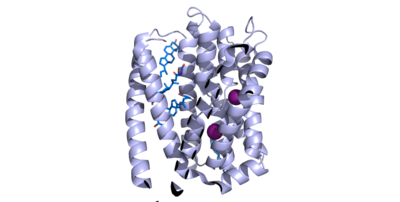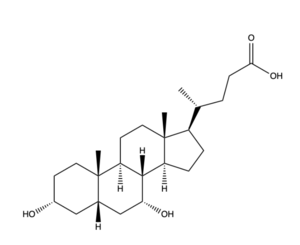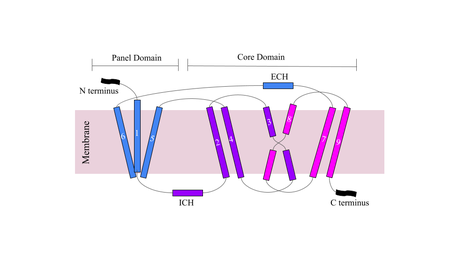Sandbox Reserved 1783
From Proteopedia
(Difference between revisions)
| Line 8: | Line 8: | ||
Sodium taurocholate co-transporting polypeptide (NTCP) is a sodium-dependent transporter that is responsible for the transportation of bile salts from the blood into epithelial liver cells. <Ref name="Goutam"> Goutam, K., Ielasi, F.S., Pardon, E. et al. Structural basis of sodium-dependent bile salt uptake into the liver. Nature 606, 1015–1020 (2022). [https://doi.org/10.1038/s41586-022-04723-z DOI: 10.1038/s41586-022-04723-z]. </Ref> NTCP is a secondary active transport molecule that couples the thermodynamically favorable movement of Na+ ions with the unfavorable transport of bile salts into the cell (Fig. 1). | Sodium taurocholate co-transporting polypeptide (NTCP) is a sodium-dependent transporter that is responsible for the transportation of bile salts from the blood into epithelial liver cells. <Ref name="Goutam"> Goutam, K., Ielasi, F.S., Pardon, E. et al. Structural basis of sodium-dependent bile salt uptake into the liver. Nature 606, 1015–1020 (2022). [https://doi.org/10.1038/s41586-022-04723-z DOI: 10.1038/s41586-022-04723-z]. </Ref> NTCP is a secondary active transport molecule that couples the thermodynamically favorable movement of Na+ ions with the unfavorable transport of bile salts into the cell (Fig. 1). | ||
| - | The bile salts transported by NTCP in the gastrointestinal tract are involved in digestion, nutrient absorption, fat breakdown, and lipid soluble nutrient transport. <Ref> Maldonado-Valderrama, J., Wilde, P., Macierzanka, A., & Mackie, A. (2011). The role of bile salts in digestion. Advances in colloid and interface science, 165(1), 36–46. [https://doi.org/10.1016/j.cis.2010.12.002 DOI: 10.1016/j.cis.2010.12.002]. </Ref> NTCP is found within the basolateral membrane hepatocytes. <Ref name="Asami"> Asami J, Kimura KT, Fujita-Fujiharu Y, Ishida H, Zhang Z, Nomura Y, Liu K, Uemura T, Sato Y, Ono M, Yamamoto M, Noda T, Shigematsu H, Drew D, Iwata S, Shimizu T, Nomura N, Ohto U. Structure of the bile acid transporter and HBV receptor NTCP. Nature. 2022 Jun; 606 (7916):1021-1026. [https://dx.doi.org/10.1038/s41586-022-04845-4 DOI: 10.1038/s41586-022-04845-4]. </Ref> The uptake of bile salts into the liver also allow for drugs and fat soluble vitamins to be both absorbed and excreted in the small intestine. NTCP also acts as a receptor for Hepatitis B virus (HBV) and Hepatitis D virus (HDV) which infect human livers through endocytosis when bound. The myristoylated (myr) <scene name='95/952711/Pres1_binding_area_on_ntcp/3'> | + | The bile salts transported by NTCP in the gastrointestinal tract are involved in digestion, nutrient absorption, fat breakdown, and lipid soluble nutrient transport. <Ref> Maldonado-Valderrama, J., Wilde, P., Macierzanka, A., & Mackie, A. (2011). The role of bile salts in digestion. Advances in colloid and interface science, 165(1), 36–46. [https://doi.org/10.1016/j.cis.2010.12.002 DOI: 10.1016/j.cis.2010.12.002]. </Ref> NTCP is found within the basolateral membrane hepatocytes. <Ref name="Asami"> Asami J, Kimura KT, Fujita-Fujiharu Y, Ishida H, Zhang Z, Nomura Y, Liu K, Uemura T, Sato Y, Ono M, Yamamoto M, Noda T, Shigematsu H, Drew D, Iwata S, Shimizu T, Nomura N, Ohto U. Structure of the bile acid transporter and HBV receptor NTCP. Nature. 2022 Jun; 606 (7916):1021-1026. [https://dx.doi.org/10.1038/s41586-022-04845-4 DOI: 10.1038/s41586-022-04845-4]. </Ref> The uptake of bile salts into the liver also allow for drugs and fat soluble vitamins to be both absorbed and excreted in the small intestine. NTCP also acts as a receptor for Hepatitis B virus (HBV) and Hepatitis D virus (HDV) which infect human livers through endocytosis when bound. The myristoylated (myr) <scene name='95/952711/Pres1_binding_area_on_ntcp/3'>preS1</scene> domain of HBV, specifically residues 8-17, is critical for its binding to NTCP which halts the uptake of bile salts, indicating that HBV/HDV bind to NTCP at the same site as bile salts. <ref name="Goutam"/> |
[[Image:Bile Salt structure.png|300 px|left|thumb|'''Figure 2.''' Bile Salt Structure. Chemical structure of bile salt molecule. Bile salt is derivative of cholesterol, as it is a steroid. Bile salts are also the main components of bile.]] | [[Image:Bile Salt structure.png|300 px|left|thumb|'''Figure 2.''' Bile Salt Structure. Chemical structure of bile salt molecule. Bile salt is derivative of cholesterol, as it is a steroid. Bile salts are also the main components of bile.]] | ||
Revision as of 22:30, 16 April 2023
| This Sandbox is Reserved from February 27 through August 31, 2023 for use in the course CH462 Biochemistry II taught by R. Jeremy Johnson at the Butler University, Indianapolis, USA. This reservation includes Sandbox Reserved 1765 through Sandbox Reserved 1795. |
To get started:
More help: Help:Editing |
Sodium Taurocholate Co-Transporting Peptide
| |||||||||||
References
- ↑ 1.0 1.1 1.2 1.3 1.4 Goutam, K., Ielasi, F.S., Pardon, E. et al. Structural basis of sodium-dependent bile salt uptake into the liver. Nature 606, 1015–1020 (2022). DOI: 10.1038/s41586-022-04723-z.
- ↑ Maldonado-Valderrama, J., Wilde, P., Macierzanka, A., & Mackie, A. (2011). The role of bile salts in digestion. Advances in colloid and interface science, 165(1), 36–46. DOI: 10.1016/j.cis.2010.12.002.
- ↑ 3.0 3.1 Asami J, Kimura KT, Fujita-Fujiharu Y, Ishida H, Zhang Z, Nomura Y, Liu K, Uemura T, Sato Y, Ono M, Yamamoto M, Noda T, Shigematsu H, Drew D, Iwata S, Shimizu T, Nomura N, Ohto U. Structure of the bile acid transporter and HBV receptor NTCP. Nature. 2022 Jun; 606 (7916):1021-1026. DOI: 10.1038/s41586-022-04845-4.
- ↑ Xiangbing Qi, Wenhui Li. (2022). Unlocking the secrets to human NTCP structure. The Innovation, Vol. 3, Issue 5. 100294, ISSN 2666-6758, DOI: 10.1016/j.xinn.2022.100294.
- ↑ Liu, H., Irobalieva, R.N., Bang-Sørensen, R. et al. Structure of human NTCP reveals the basis of recognition and sodium-driven transport of bile salts into the liver. Cell Res 32, 773–776 (2022). DOI: 10.1038/s41422-022-00680-4.
- ↑ Vlahcevic, Z., Buhac, I., et al. Bile Acid Metabolism in Patients with Cirrhosis. Gastroenterology vol. 60, 491-498 (1971). DOI: 10.1016/S0016-5085(71)80053-7.




